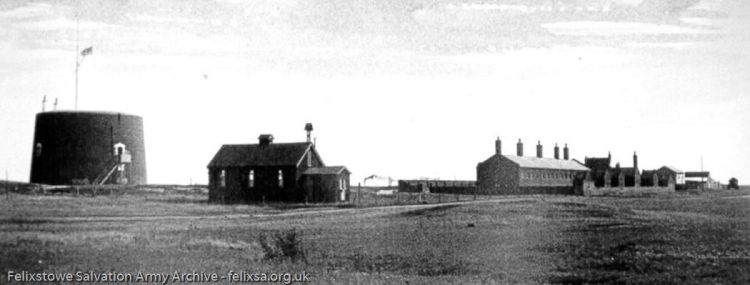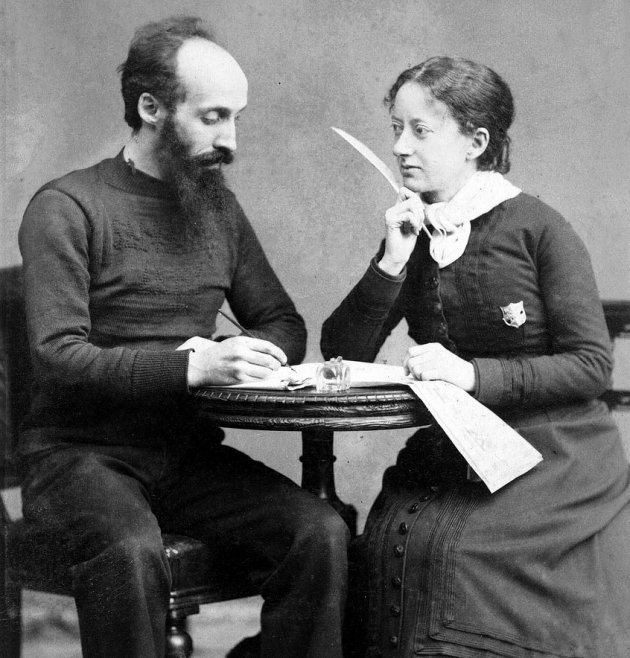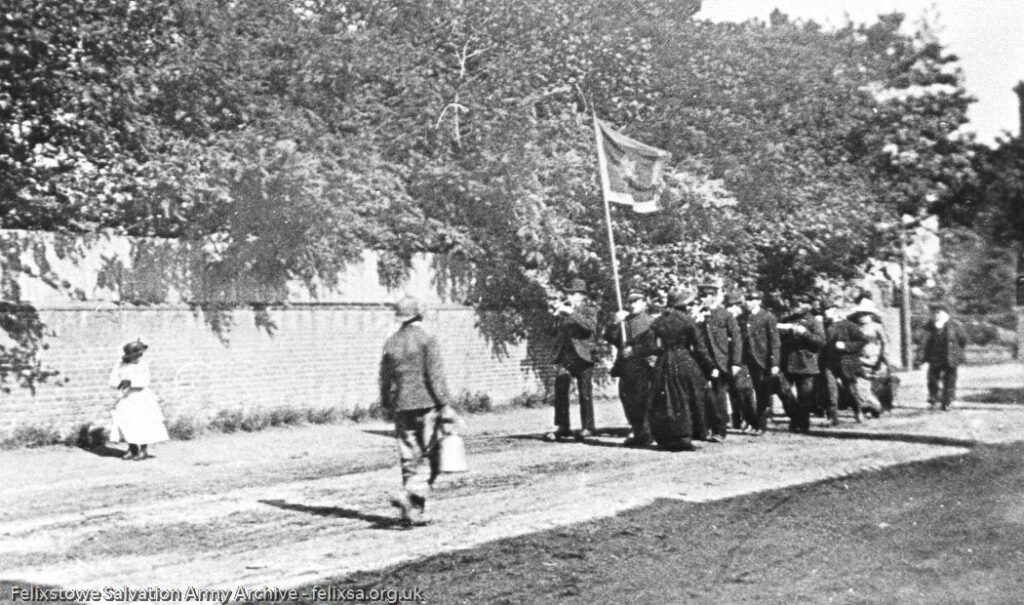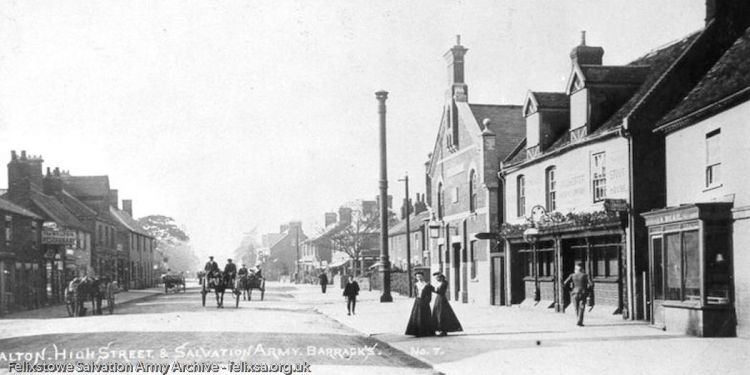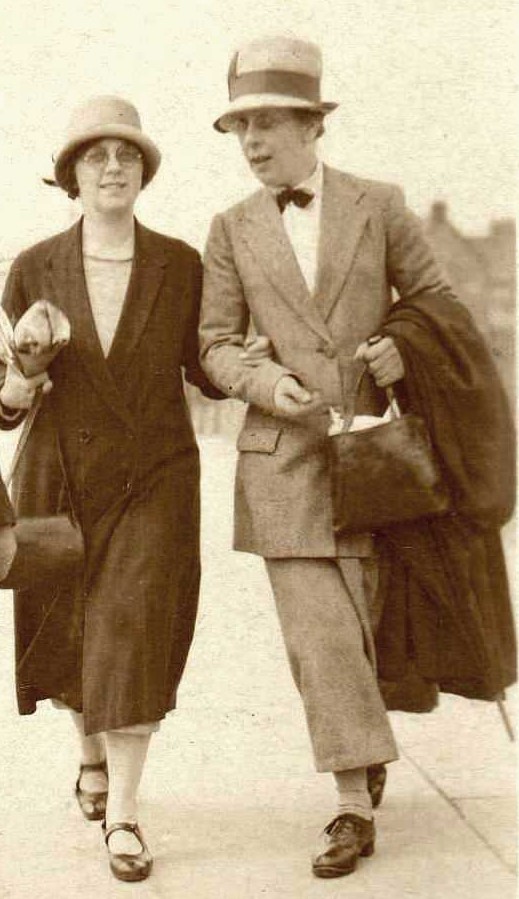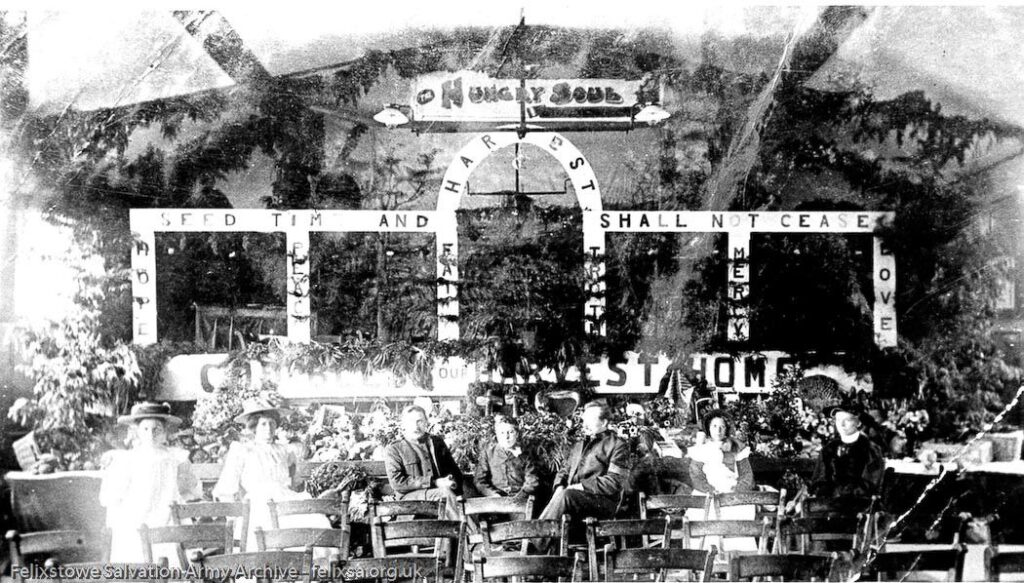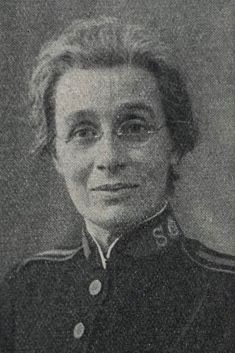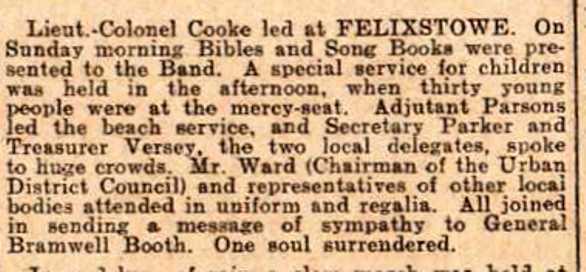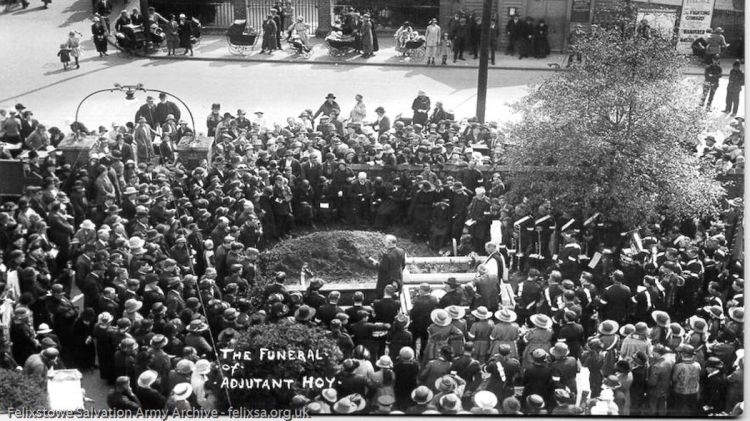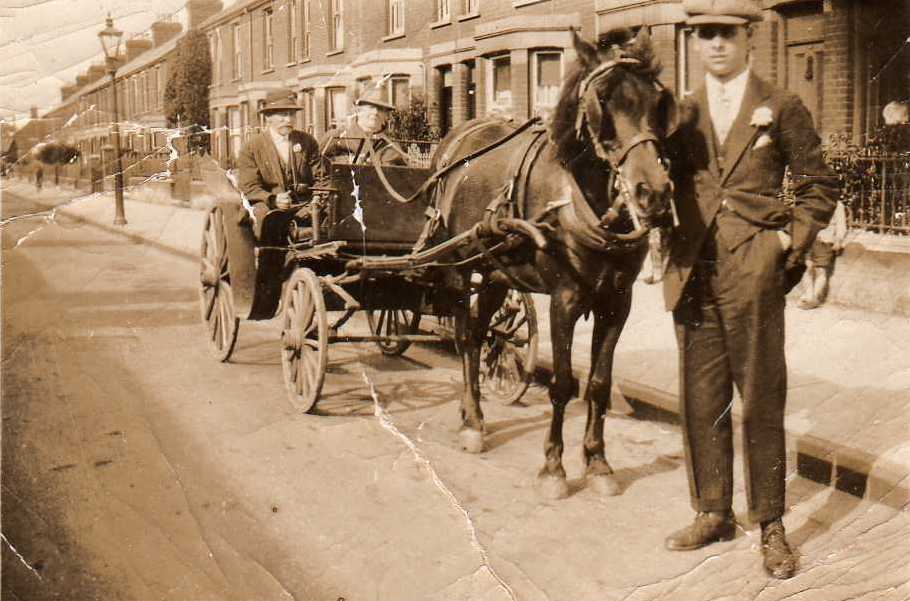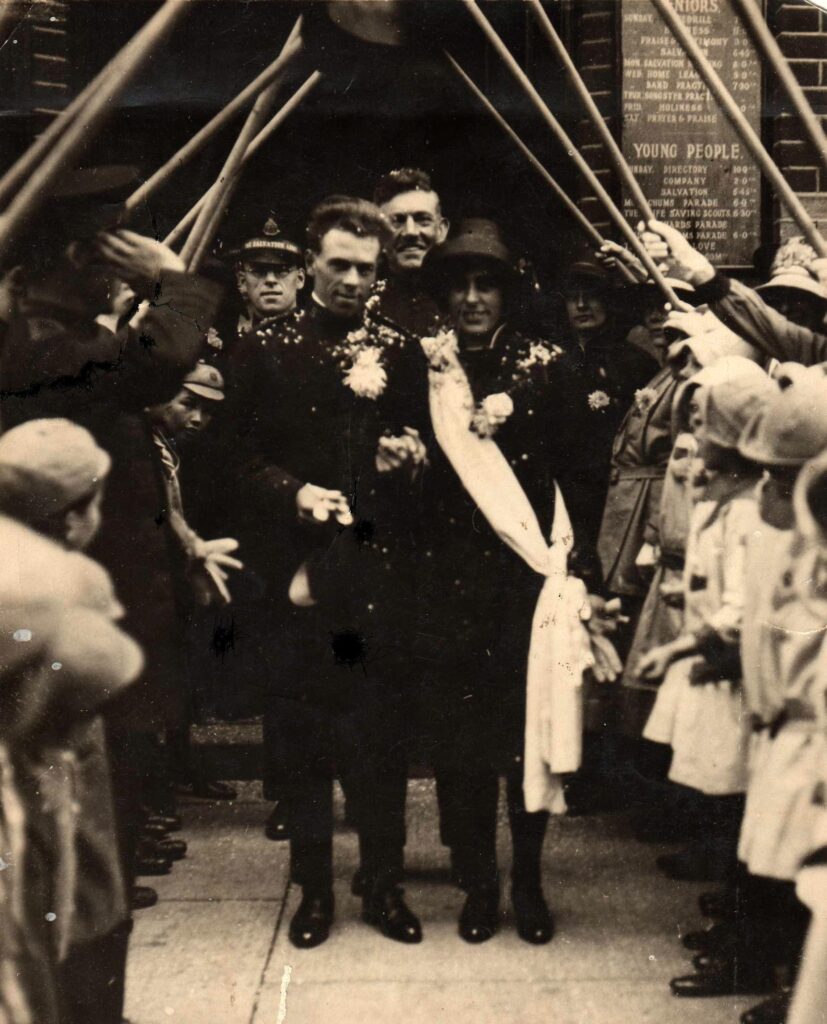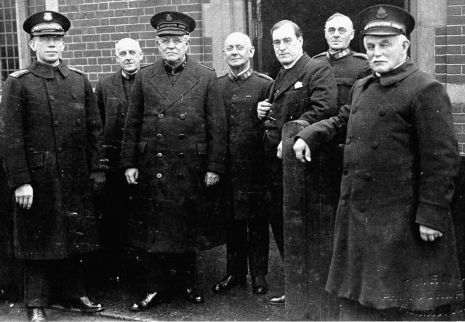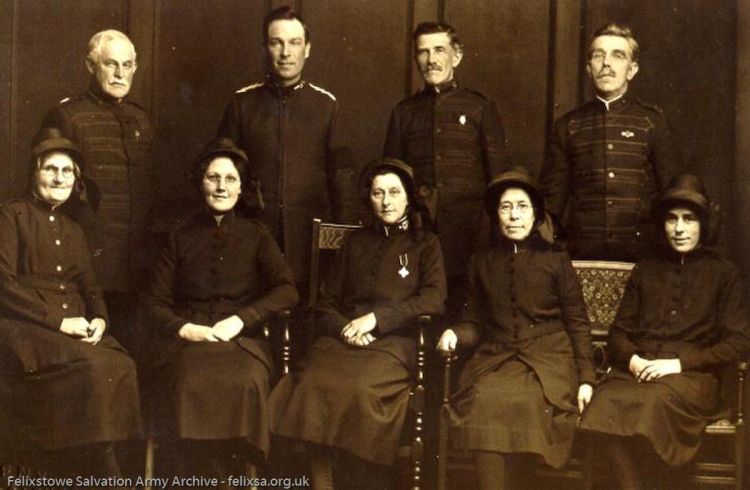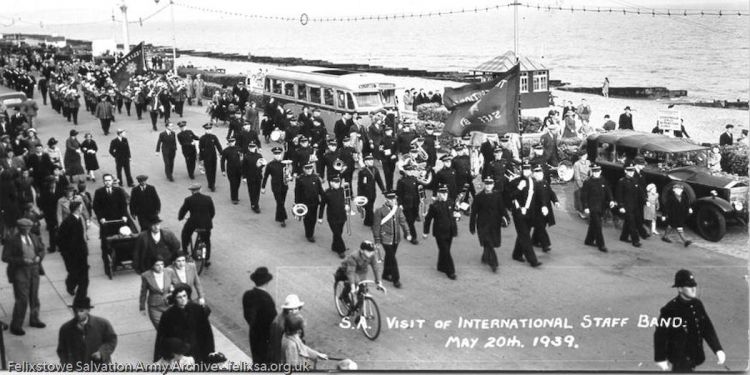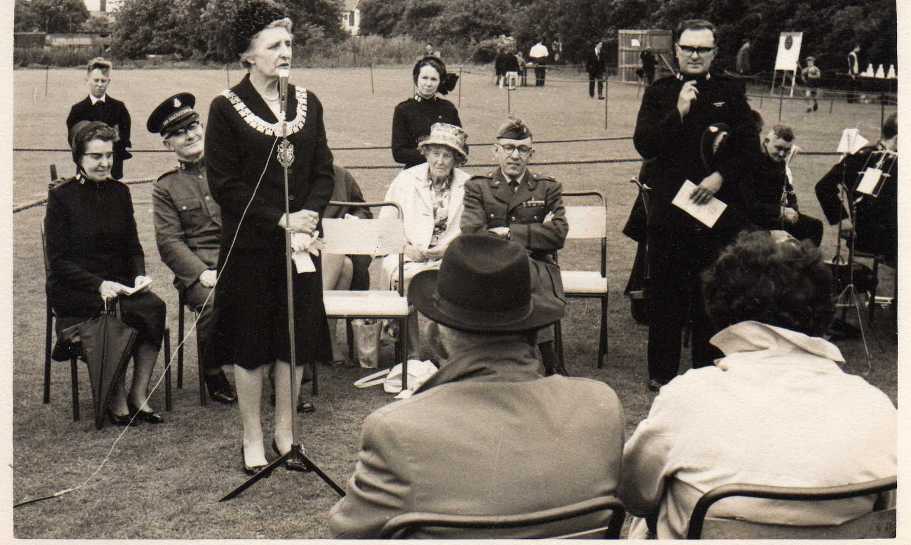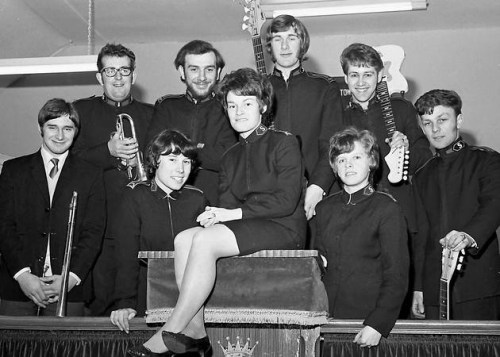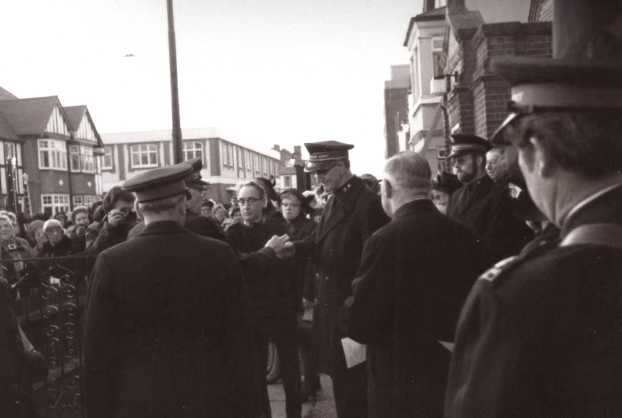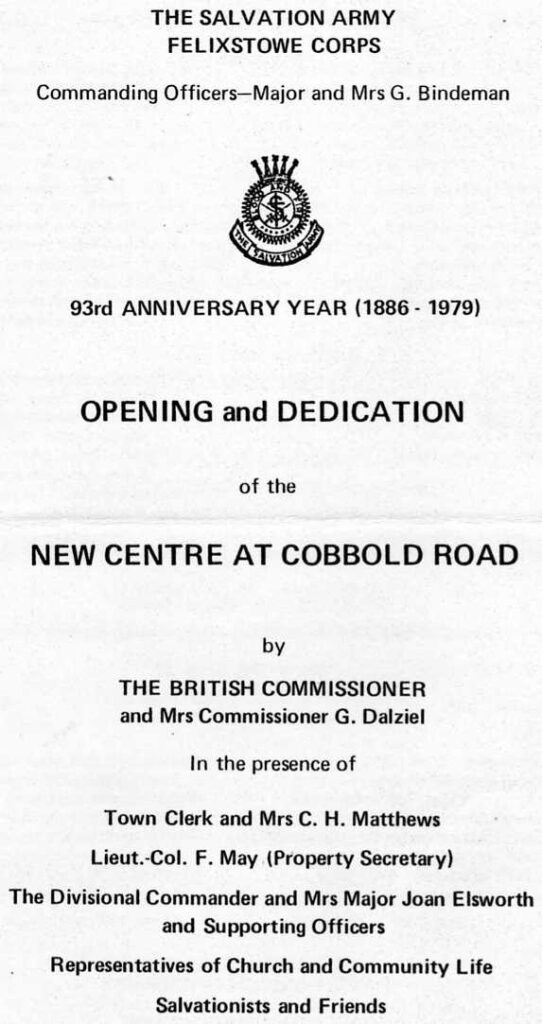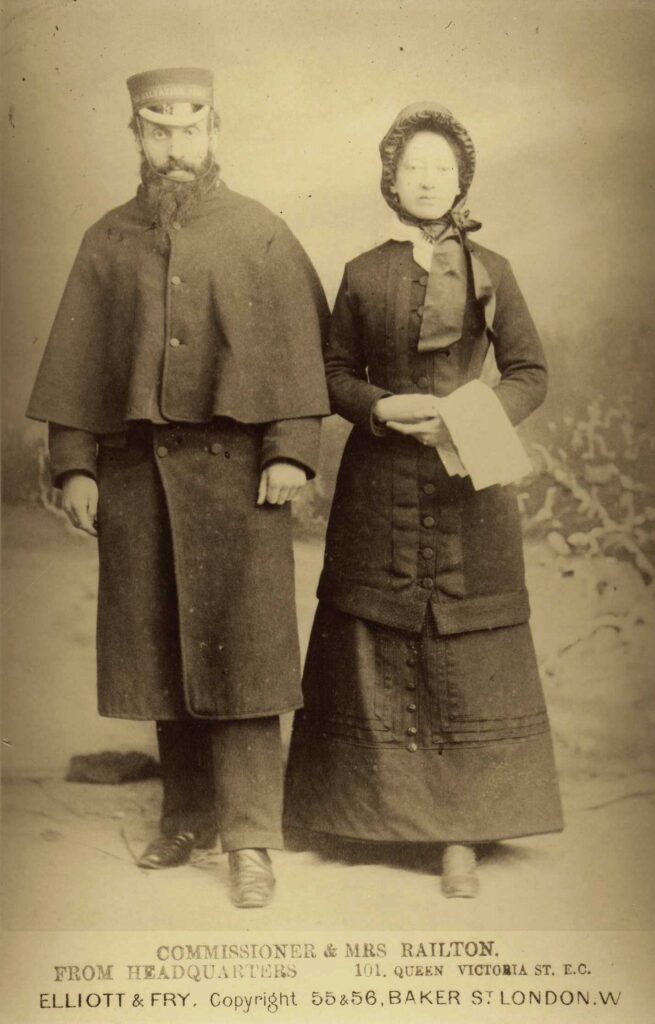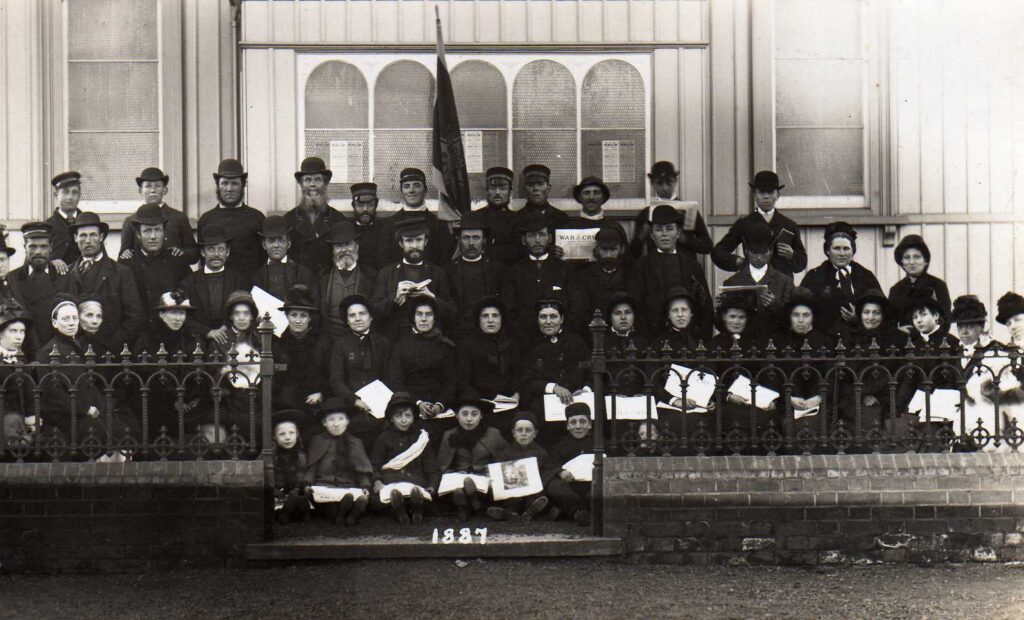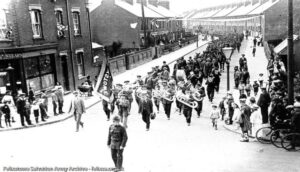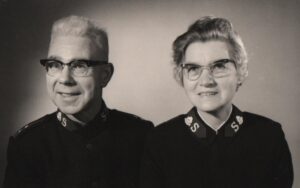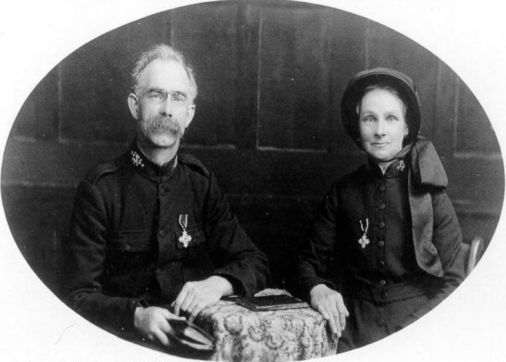The ‘War Cry’ and a honeymoon
– a ship’s pilot and his wife entertain Railton..
William Gardner Frost, a Trinity House pilot, married Louisa, a Christian woman who originated from Bristol, at the age of 22 and with her began attending services at the little Methodist chapel immediately adjacent to their home, Mariners’ Cottages, at the hamlet known then as now, as Felixstowe Ferry. The cottage was between the Martello Tower and the Victoria public house. It wasn’t until he was 40, and after the faithful intercessions of Louisa, that William sought Salvation. Pilot Frost was, we are told, an enthusiastic Christian and arrived home one day brandishing a copy of the War Cry. He told Louisa that the people who wrote it were the people for him, and couldn’t rest until he could get to the nearest Salvation Army corps of that time, Harwich. Shortly after this Frost was told that two Salvation Army officers were ‘resting’ in Felixstowe, a Captain Rose Fyshe (who came originally from Norfolk) and a Lieutenant Wright. He made contact with these two women officers and arranged for them to speak at the chapel he attended. We believe that the chapel was crowded for the service – in no small measure due to the fact that these were the first two Salvationists ever to be seen in the area.
A few weeks later Frost received a letter from the Divisional Commander asking if one of the Army’s leading officers, George Scott Railton, might stay with the Frosts with his new bride, Marianne. The War Cry of 16 November 1889 later recalled: ‘On reading the letter Brother Frost and his wife burst into tears of joy at the prospect of at last getting some Salvationists near to them, they fell on their knees and thanked God with all their hearts for answering their prayers’
Commissioner George Scott Railton & his new bride, Marianne Parkyn, married at London’s Exeter Hall, attended the small chapel as worshippers on the first Sunday of their honeymoon, 18 January 1884 with only six other people present. On the second Sunday George was invited to conduct the service. Word had got around, and the chapel, which only seated 80, was full to overflowing with people standing outside, souls were saved. The next Tuesday the chapel was packed again with more than a dozen seeking Salvation and from this the nucleus of a corps formed. These early converts began to hold meetings in their own homes but it was two years before headquarters appointed an officer, Captain John Reeves.
Opening of the corps
We have seen how many in Felixstowe had already been attracted to The Salvation Army before it officially opened, among those early converts were members of the Plant, Nice, Horsley and Versey families. By 2022, 136 years later, there are still Verseys in the corps, (Robert has carried the flag for more than 50 years). The corps first met in a hall in Orwell Road, said to have been a ‘sailors reading room’ and constructed of wood.
The hall was demolished several years ago and the Broadway Community Hall now stands on the site.
Within a few years, and no-one is sure why, the corps moved to the Walton area on the western edge of the town, to the Ancient Order of Foresters Hall that still stands facing King Street. To begin with the hall was not available during the week so the corps also used ‘the Adult School’ – a corrugated iron building at the rear of Queen Street. The writer of this page recalls this old building – now gone and a housing estate fills the site. The meetings held in the Foresters’ Hall were initially disturbed by what Samuel Wall, Felixstowe historian, described as a ‘rowdy element’, but a few local traders and other influential men sat among the congregation to help keep order. These early day Salvationists elected Brother Carr, an early convert, as their leader, and included in the photograph on the right are Mr. & Mrs. Gardener Frost, Mr.& Mrs. Charles Plant, Mr.& Mrs. Horsley, Mr.& Mrs. Tom Nice, Mr. & Mrs. Charlie Versey, Charlie Ford, Mrs. Morris with her sister and parents.
Young People’s Work
The corps has always had a strong YP work, from junior soldiership through to its ‘life-saving’ sections – later known as Baden-Powell sections – corps cadets, Torchbearer youth club, YP band & singing company. Many have served the young people – some for many decades, YPS-M Millie Bond, YP Bandleader Willie Fisher and many others from the distant and more recent past. The 1930s in particular produced a flurry of candidates for officership, in no small part due to the influence of Corps Cadet Guardian Mrs Jennings. Corps cadets were discontinued nationally in the UK several years ago and former CCG Roy Aldis commented that in part it may be no coincidence that in recent times the number of cadets entering the training college annually from the whole territory has been just ten.
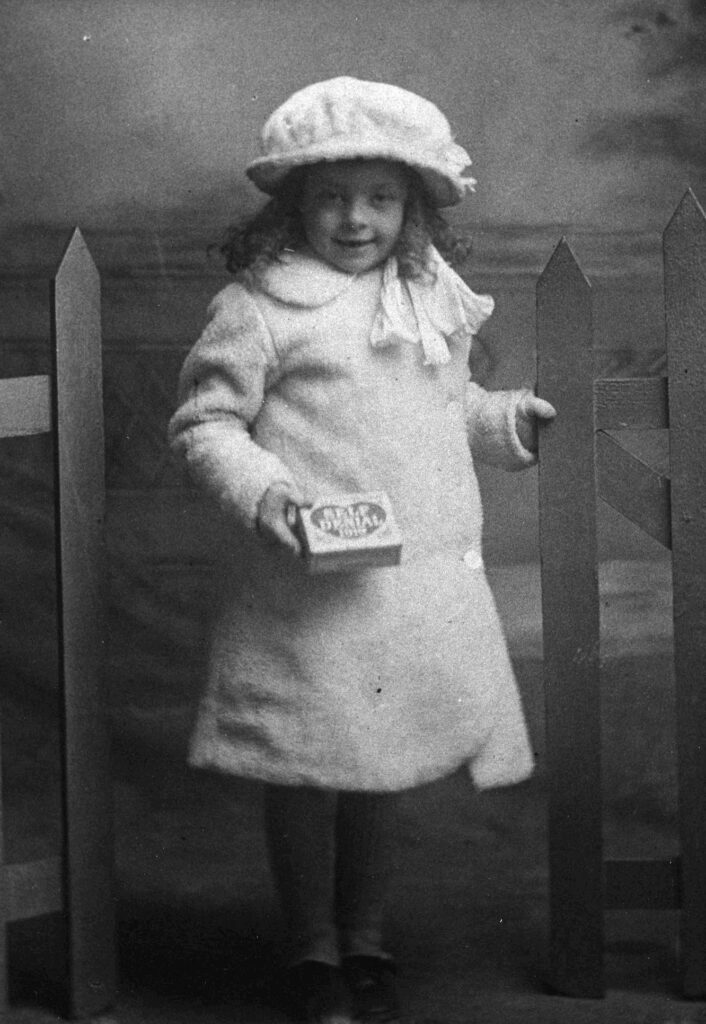
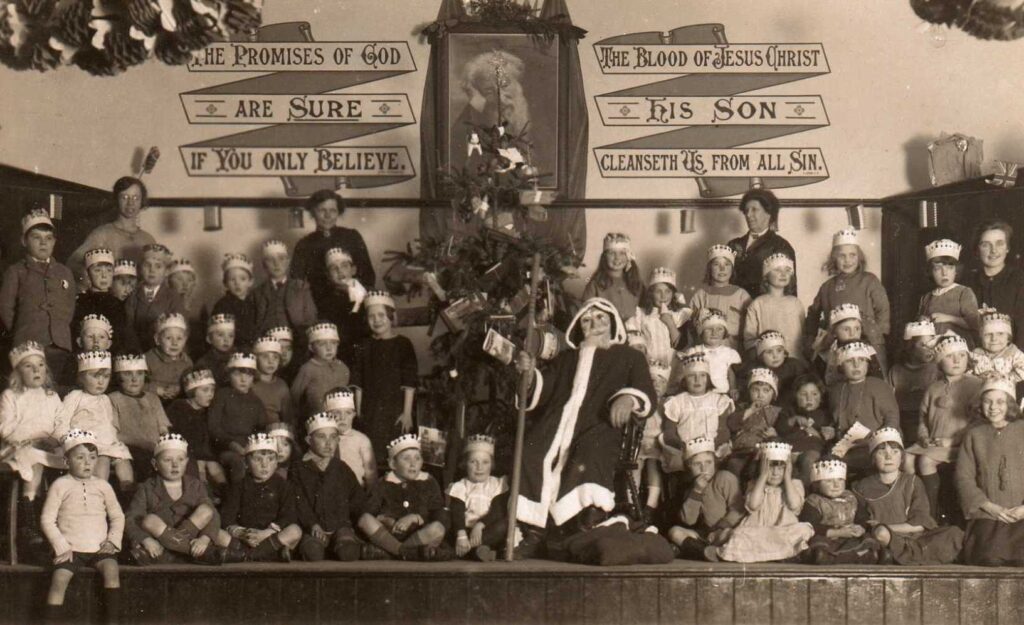
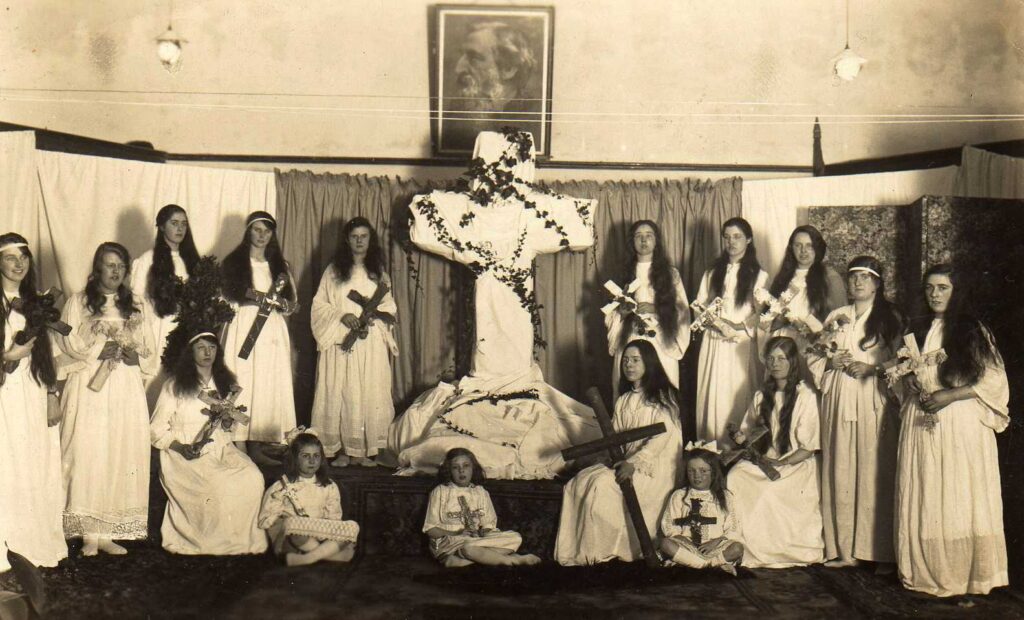
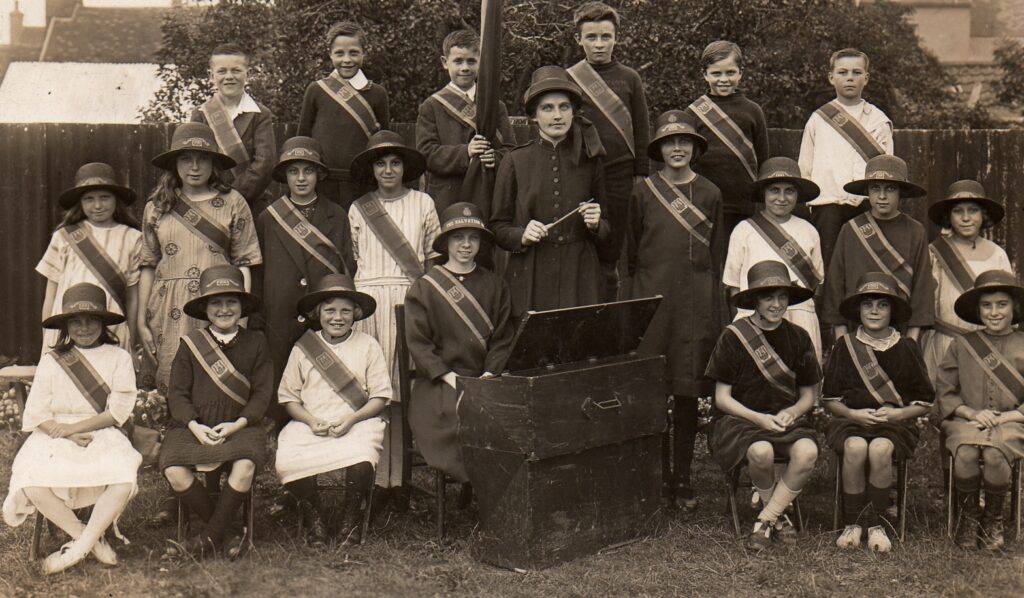
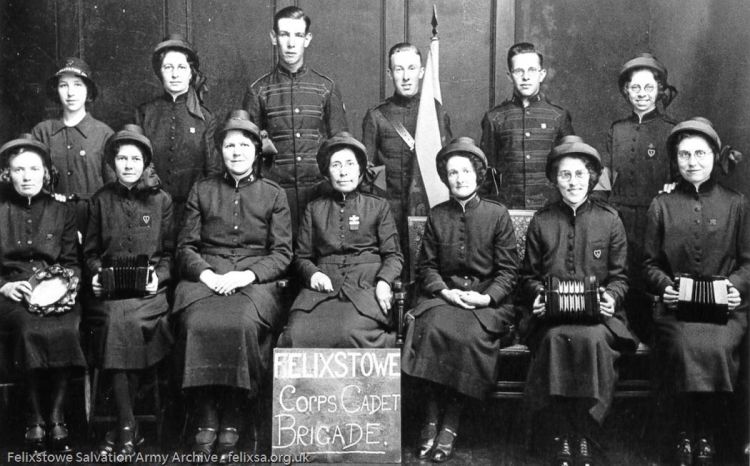
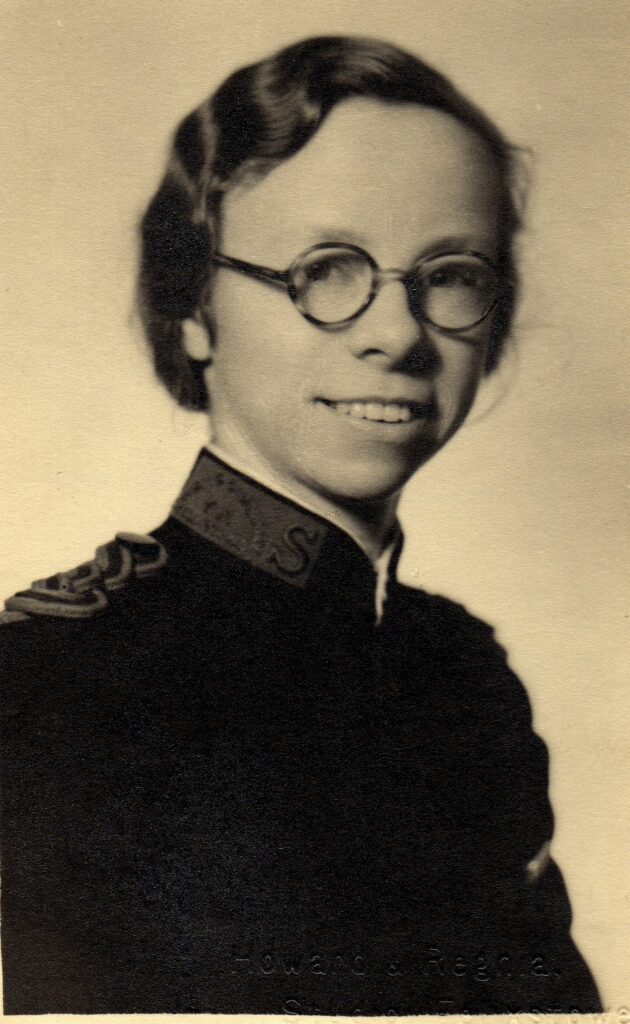
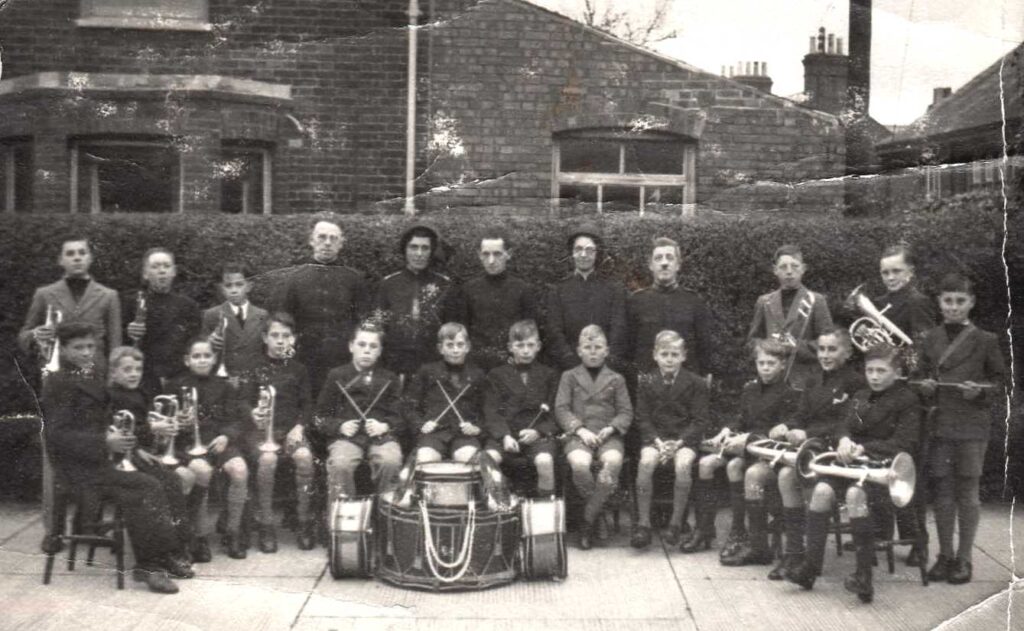
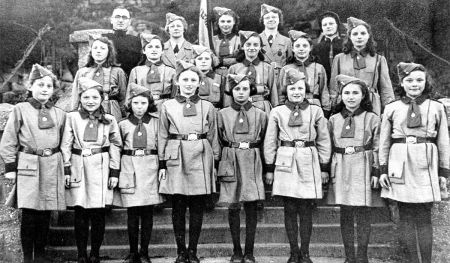
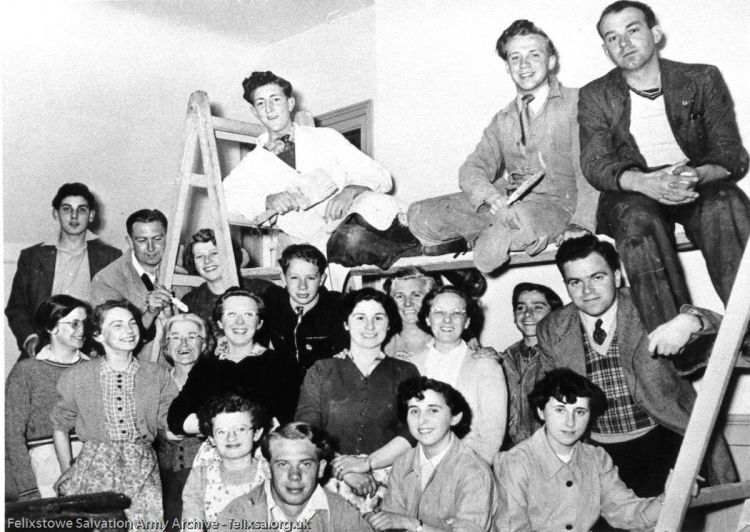
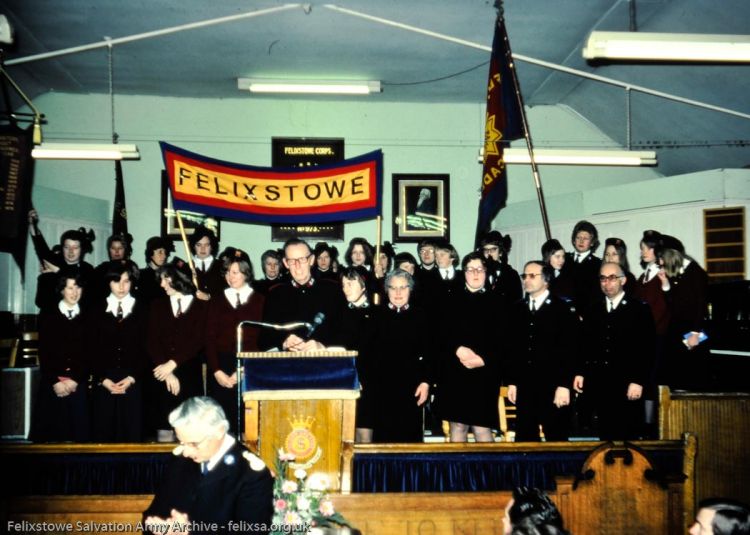
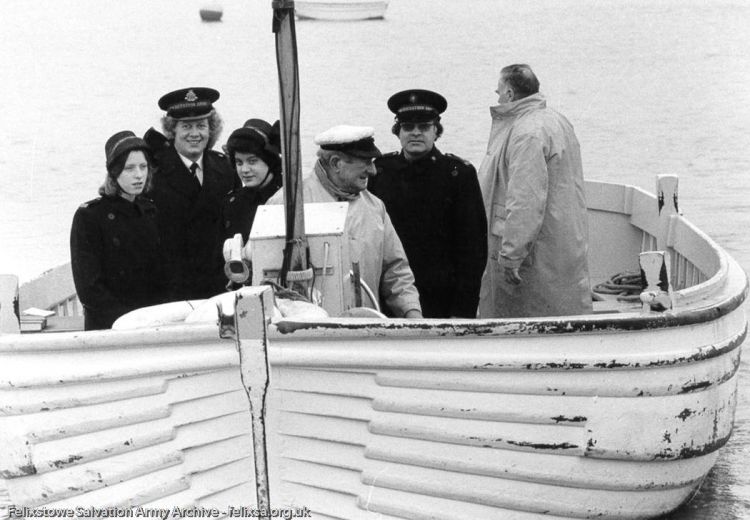
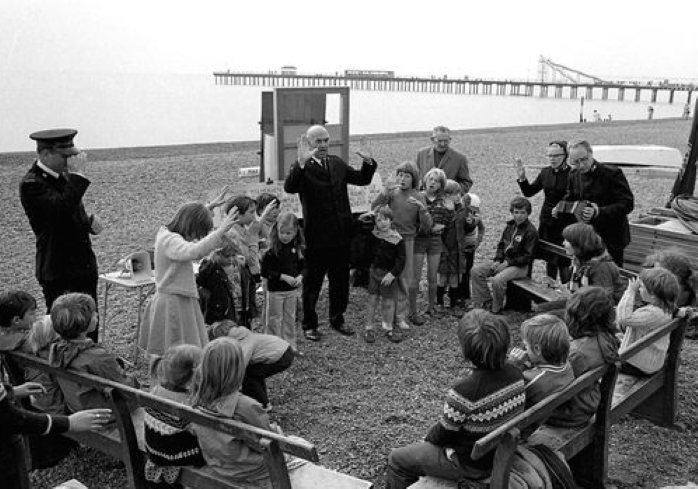
Beach Meetings
Overcoming initial opposition, for many years from 1909 the corps held a Sunday afternoon meeting on the beach opposite to the Town Hall on Undercliff Road West at 3pm. These meetings attracted large crowds – sometimes hundreds of people gathered on the promenade and the adjacent gardens. Brother George Fricker, a former officer, would hand out song booklets and go around with the wooden, and latterly plastic, collecting box, Brigadier Will Trinder (R) would sit holding the flag with his one arm and all the music sections would take part.
An anecdote told by Lieutenant-Colonel Olive Booth and her sister Major Dora Booth involves them visiting the corps from Ipswich DHQ and leading a beach meeting. “As we were leading a song we spotted Colonel Dalrymple on furlough walking along the promenade. We started to outline the first verse, ‘The Great Physician now is near..’ and broke off, ‘Yoo-hoo, Dalrymple’ – he was not of course the great physician!”. The sisters found this story very amusing and it testifies to their sense of fun.
The trusty Triumph organ (now owned by the writer of this page) would be carried down the cliff steps (transported in the songster leader’s Ford Cortina) and the metal folding chairs unchained (they were kept on the beach all season on the wooden platform), with a specially adapted chair for the organist so that it didn’t sink into the beach as the organ was pedalled.
The band would march to the meeting from the cliff top down Convalescent Hill – a challenge to play and march down such a steep hill, and more so for the colour sergeant trying to hold the flag – especially on a windy day. Bob Versey, at the time of writing, has carried the flag for more than 50 years, carrying on the tradition from his father before him.
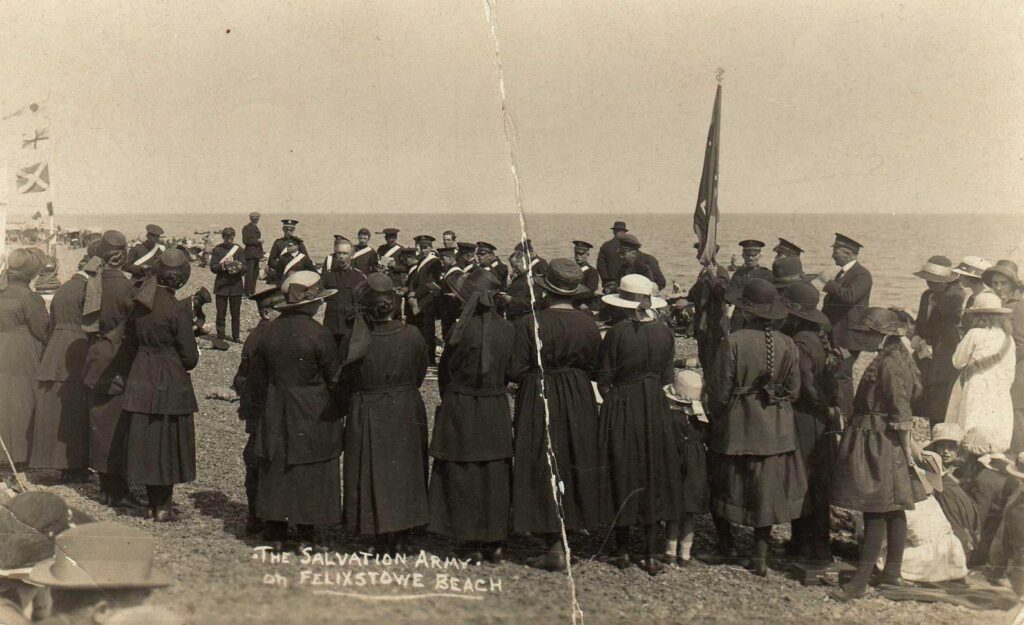
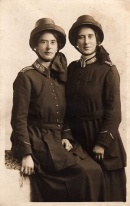
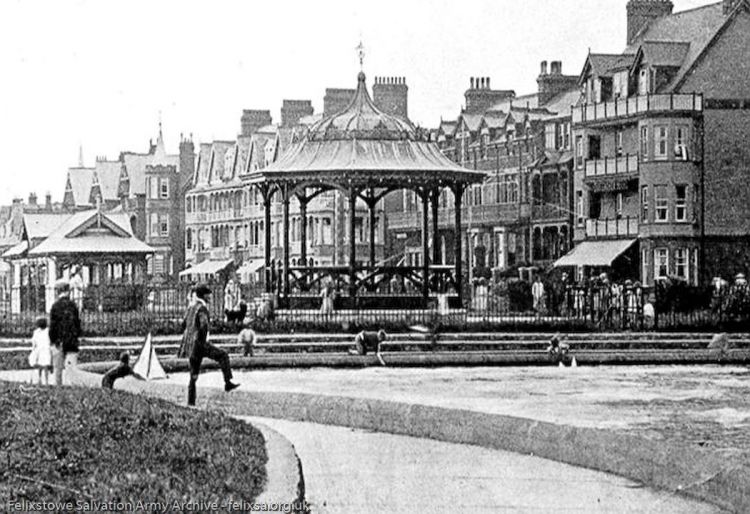
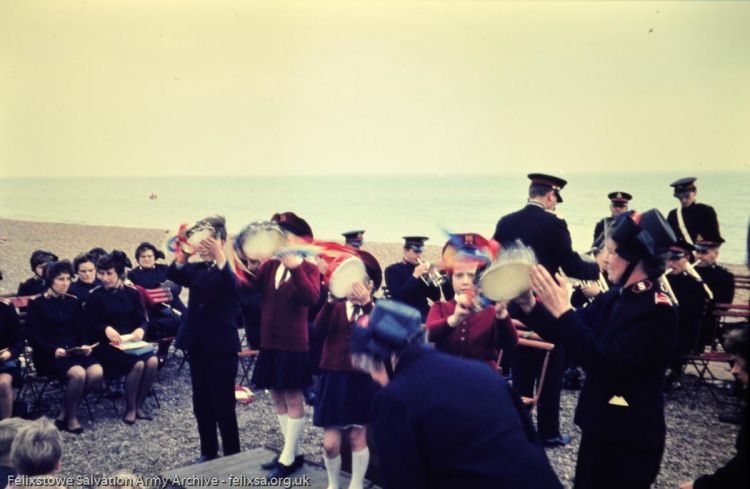
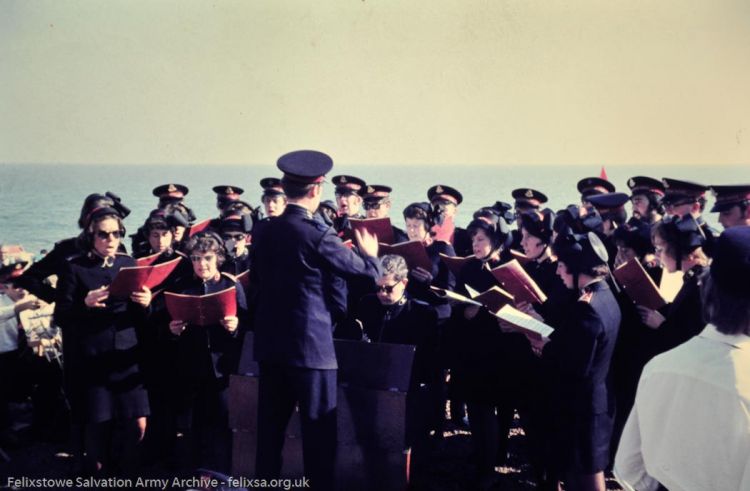
After the 1939-45 War ended the beach was still out of bounds and the bandstand on the green between Sea Road and the promenade was used for the meetings – a location used for an 8pm evening open-air meeting on Sundays after the Salvation Meeting concluded in the hall, even after the bandstand was demolished. This would have been the seventh meeting of the day!
During the 1990s these meeting were discontinued – possibly due to changing ideas of evangelism, or to make Sunday less frenetic (the band would have already been at three meetings, and three more would follow). These days (2022) following erosion the beach at this point almost disappears at high tide so the meetings would not be possible, at least at the same spot, but the contacts made by Salvationists that mingled with the people – YPS-M Arthur Parker in particular – had considerable influence for good and helped maintain the high profile of the Army in the town.
The Mercy Seat 1923
The new oak Mercy Seat or Penitent-form was first installed in the Walton High Street hall in 1923 when Ensign (later Commissioner) and Mrs. William Grottick were the commanding officers. The corps arranged for this provision as a memorial to Felixstowe Salvationists who made the supreme sacrifice in the 1914-1918 war. In the picture below we see the father of one of those killed, Corps Treasurer Henry Parker, the contractor responsible for its installation together with the Commanding Officer, the Commanding Officer’s father: Commissioner Grottick, his brother: Lieutenant Albert Grottick and Brother Harry Parker Jnr. In 1979 when the corps transferred to its present premises in Cobbold Road, a special sense of continuity was provided by the installation of this same Mercy Seat in the new premises. A modernisation of the worship hall in 1995 resulted in it being replaced. Older comrades who mourned the loss of the old mercy seat were comforted when it was explained that a mahogany cross placed on the wall behind the platform, was said to have been made out of the wood. Somewhere the panel with the names of the men who gave their lives is said to be stored – but no-one is sure where!
Text:
This penitent form was erected to the memory of:
Bandsman W Bond
Bandsman G Butcher
Bandsman G Crofford
Brother V Parker
Brother J Peck
Who fell in the Great War
1914-1918
On the left panel are inscribed the names of the fallen, on the right panel the words ‘I am the Resurection and the Life. He that believeth in me, though he were dead, yet shall he live’. The eagle-eyed observer will notice that Resurrection was incorrectly spelled. In the centre two panels were the words: ‘ABLE TO SAVE, ABLE TO KEEP’.
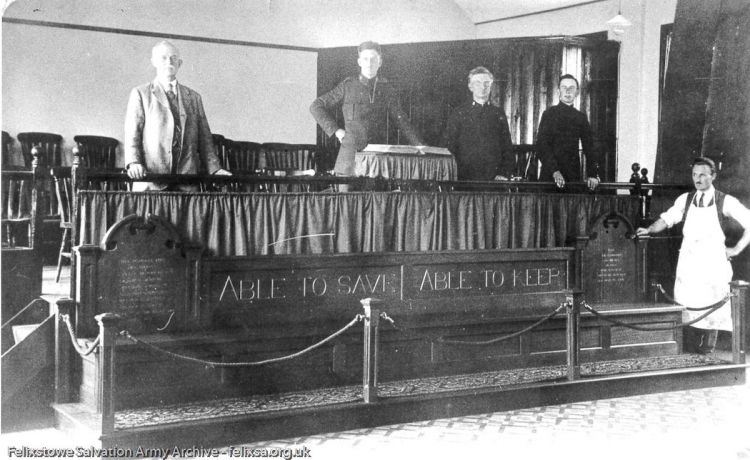
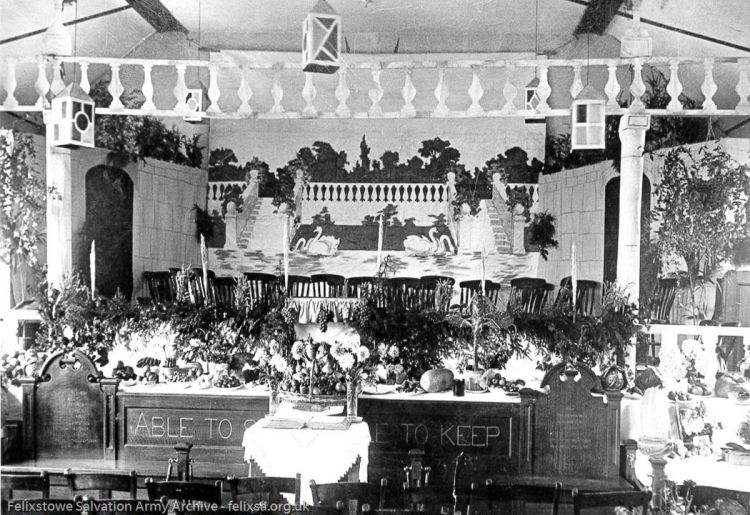
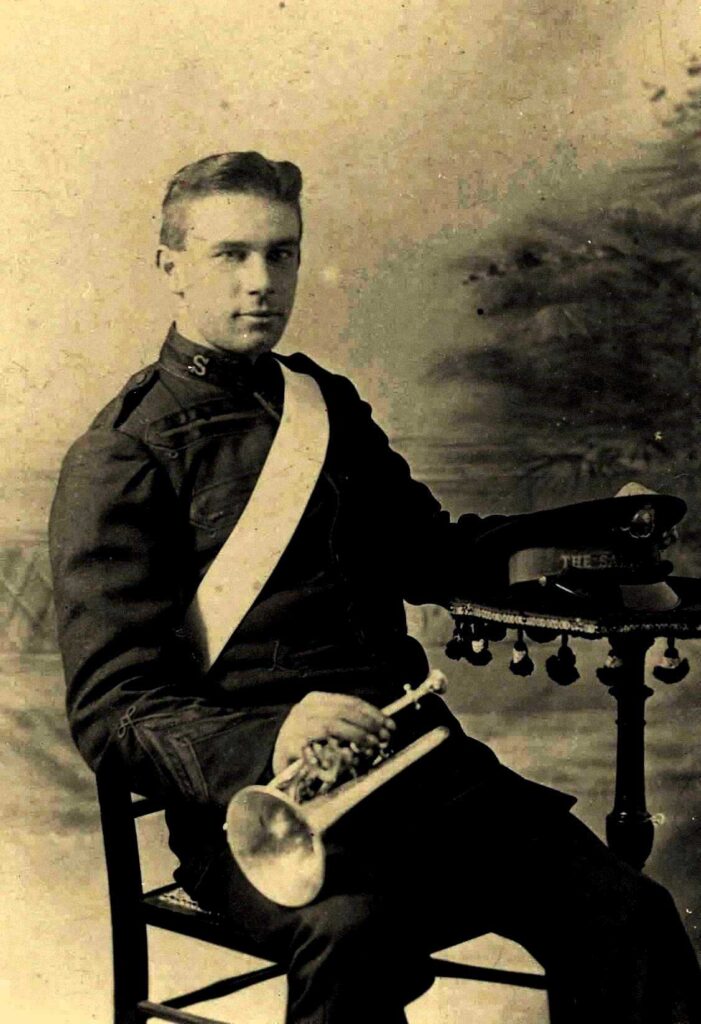
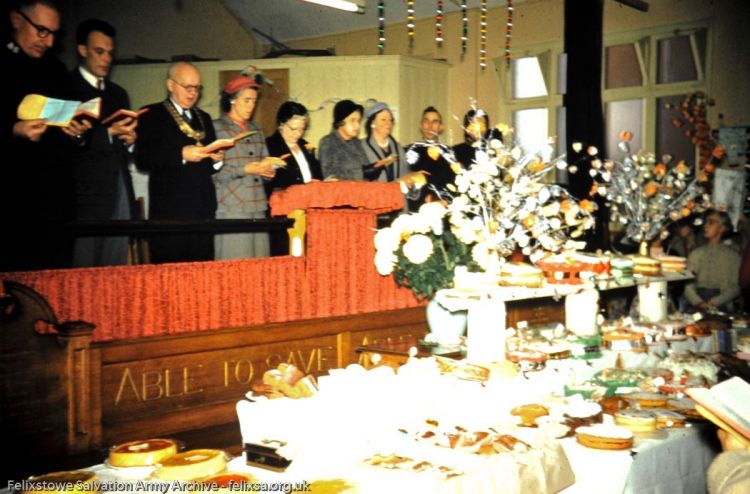
As was fashionable at the time, posts and ropes surrounded the mercy seat and a matching ‘Holiness table’ was placed in the centre with the one word chiselled into it: ‘Ebenezer’ (Hitherto hath the Lord helped us). The table is also now lost.
First World War
In 1918 the Band led a massive parade to celebrate ‘Peace Day’, following the cessation of hostilities in the 1914-1918 Great War. Several bandsmen were still not home from active service and therefore members of the Young People’s Band were assisting (the Young People concerned were members of the first official Young People’s Band in the corps).; they found the day exciting but tiring, not having previously having had to play and march simultaneously. The procession toured the town culminating at the Town Ground where the Band played at intervals during the remainder of the day whilst sports activities were held. In the evening at a field where the present day Post Office stands, a huge bonfire was lit, there being no buildings in that vicinity from the Railway Station downwards. The police officer on duty was Harry Vince and on the right of the colours, carrying a cornet case, was Mr.Charlie West whilst to the right of the colours was Mr. Bob Andrews, the then Chairman of the Town Council. On the 11th day of November, 1918 when Peace was declared, a tremendous impact was made on all who lived and worked in the vicinity of The Salvation Army, by the commanding officer, Major John Hill, standing alone on the step of the SA Hall and playing on the cornet “Praise God, from whom all blessings flow” The impact was such that those who heard never forgot and talked about it for many years.
Roll of Honour
- (Charles) Wesley Bond promoted to Glory 22 April 1917 aged 23. Buried at Philosophe British Cemetery, Mazingarbe, France.
- G Butcher
- George Newman Crofford promoted to Glory 9 August 1917 aged 36. Buried at Brandhoek New Military Cemetery, Belgium.
- Victor Parker promoted to Glory 24 April 1918 aged 18. Commemorated on the Pozieres Memorial, France.
- James Peck promoted to Glory 9 June 1918 aged 18. Buried at Sucrerie Cemetery, Ablain-St Nazaire, France.
Second World War
Although attack from the air was a factor in WW!, in WW2 this threat was hugely increased and Felixstowe residents were urged to evacuate. The population of the town dropped by more than half and Salvation Army activities were curtailed, both due to lack of personnel and the blackout. A combined YP and senior band operated for instance, though many young people were sent away for their safety – the mother of the writer being sent to Redditch for instance. The pier was breached to prevent invasion and the beach was cut off from the seafront by concrete blocks and barbed wire. Despite all of these difficulties the corps soldiered on!
Roll of Honour
- Wilfred Harrold promoted to Glory 9 April 1943 aged 23. Commemorated on the Medjez-El-Bab Memorial, Tunisia.
The East Coast Floods
On the night of 31 January 1953 freak winds drove a storm surge down the North Sea. By evening this had reached the East coast of England where sea defences were over-topped and damaged by the huge waves. The horror of the flood hit late evening and during the night when many were asleep and 41 townspeople were drowned. Practical help was given by the local corps led by Major & Mrs Murray, helped by staff from Divisional Headquarters (in those days based in Ipswich) including Brigadier Edward & Mrs Hilda Newall.
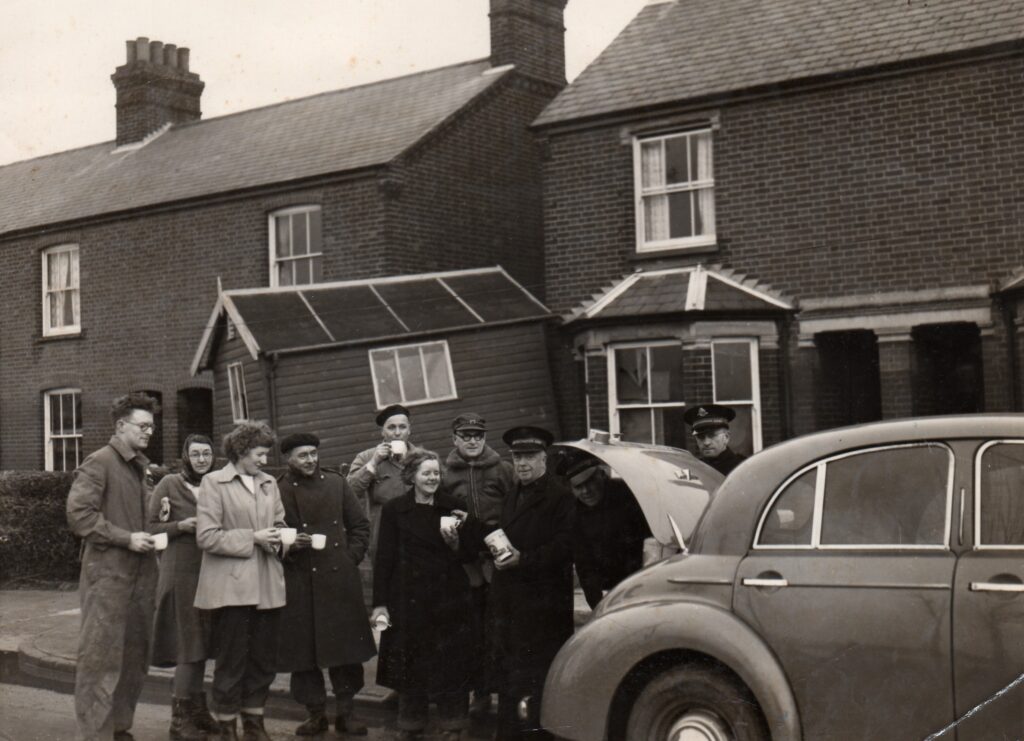
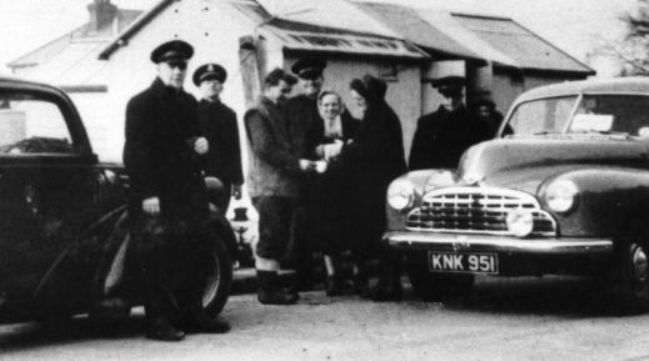
Band Reservist Peter Howlett, in those days living in the area affected, still recalls that fateful night:
“We had been with the songsters to Trimley Methodist Church that evening to present a programme of music. The following morning the force of the flood water had tipped over the piano in our front room; arriving home late we had left our music on top of the piano and the following morning we saw it, opened to the page ‘This is the day that the Lord hath made’ – we saw the irony of it!”
The Home League
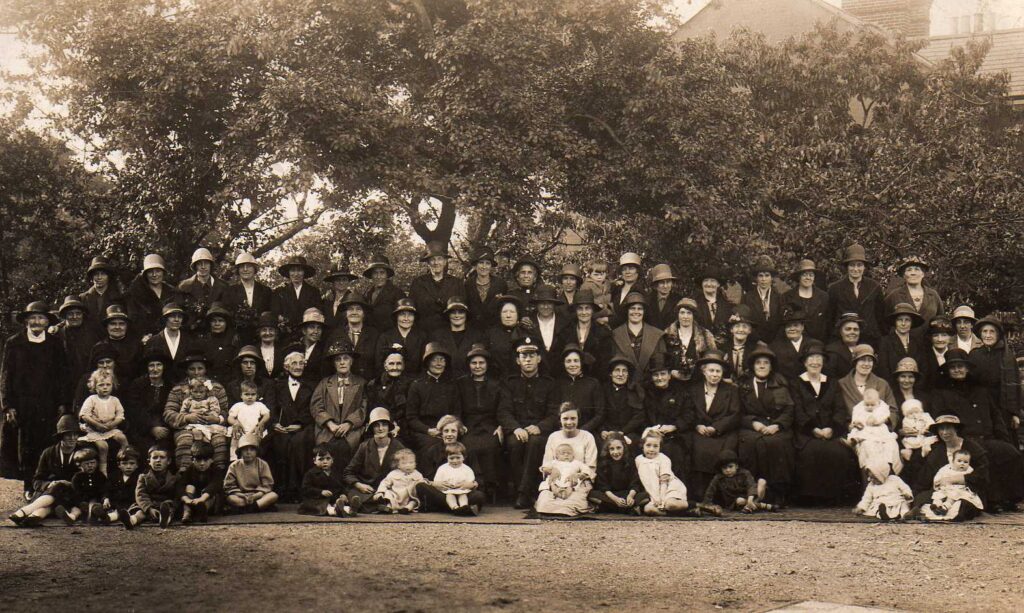
The Band
Music-making has always been a strong feature of the corps and the band has long been held in high regard in the town.
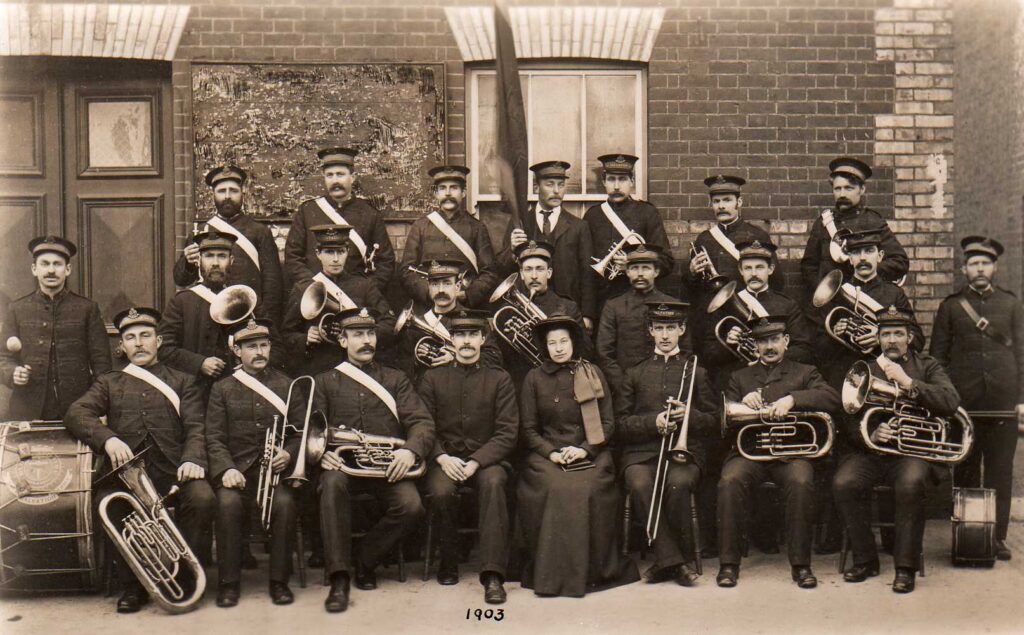
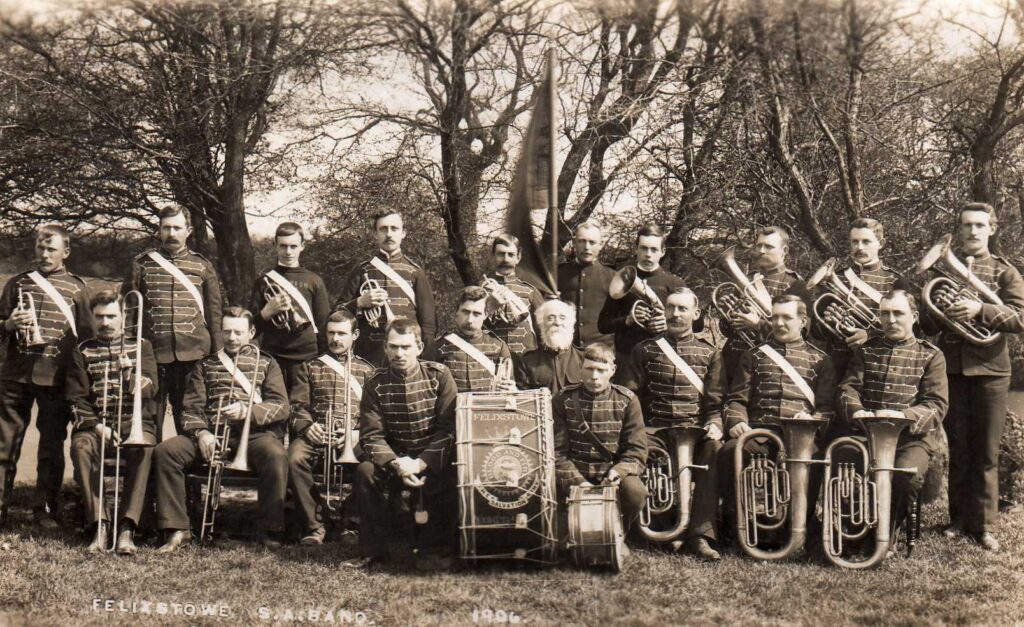
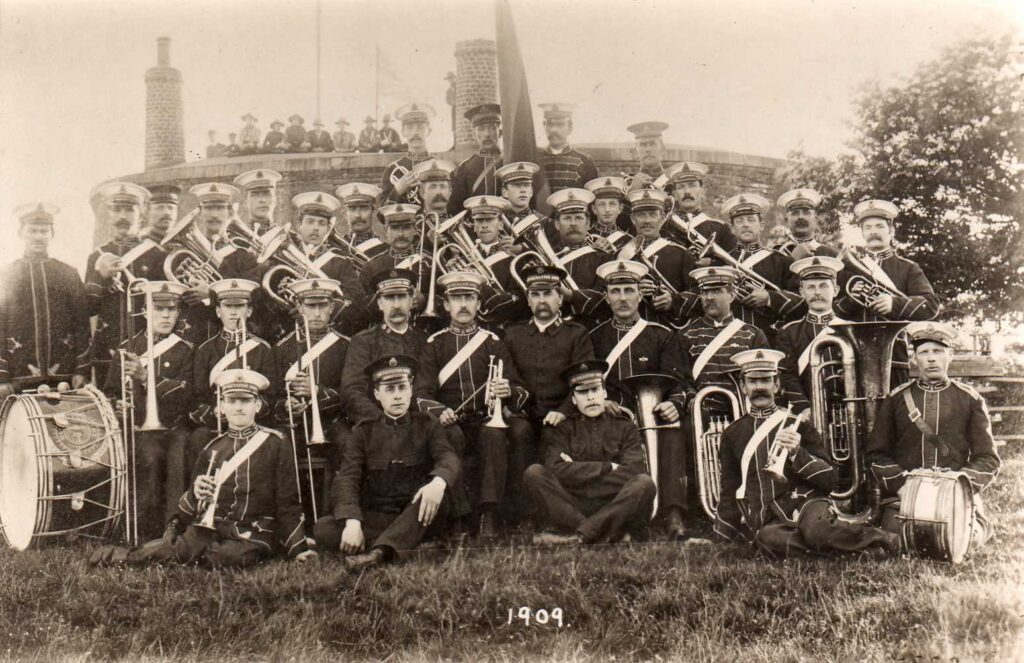
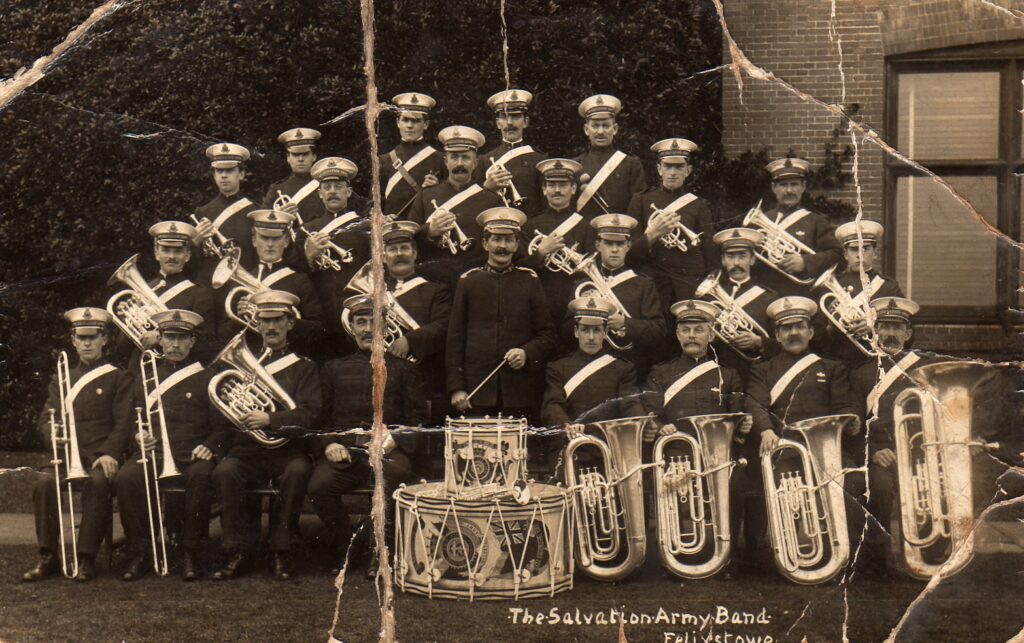
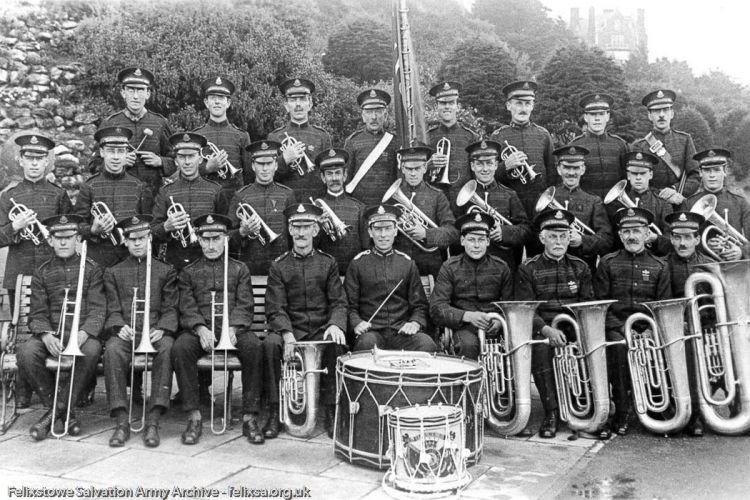
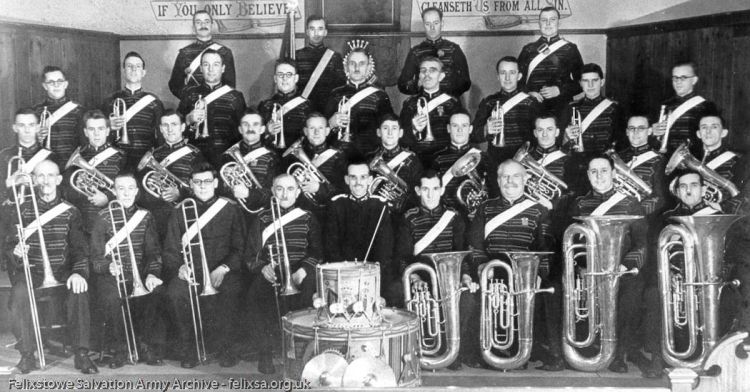
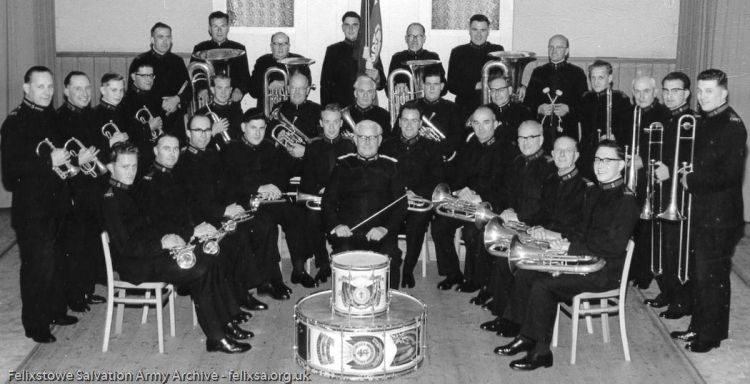
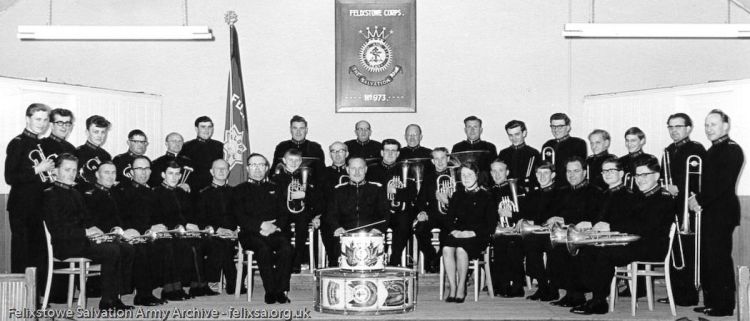
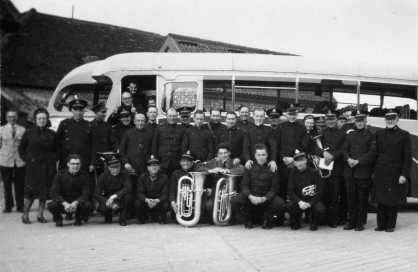
Bandmasters and local officers
Many have served the band:
Bandmasters:
- George Knights
- Walter Jennings
- William Todd
- Leslie Howlett
- Harry Sayce
- S Montague Baker
- Wycliffe Baker
- Peter Howlett
- Bernard Rayner
- Howard Cracknell
- John Ranner
- John Pulborough
- 2017 Simon Scott
– with other band ‘locals’ in support – especially some of the ‘behind the scenes’ people such as long-serving band librarian Ken Day who also served as scoutmaster for many years, his wife Molly serving as cub-leader.
Band League
We must not forget those that supported the band financially in days gone by – we recall those amazing Band League teas in the Walton hall, with Mrs Runnacles & Mrs Hood in charge of those big brown enamel teapots! Whether the small weekly subscription covered the cost of the high tea is something we may never know.
The Songsters
The date of the formation of the songster brigade is at present lost in the mists of time, but we know that they were disbanded at some point & were re-formed in 1922. The first photograph below shows the songsters in 1926; Harry Parker is the leader, and others in picture include future leader Jack Todd (far right, middle row), and the future Brigadier Will Trinder (fourth from left, back row), whose parents were the COs in 1922. Third from left on the front row is thought to be Eva Parker who entered the International Training Garrison a year later.
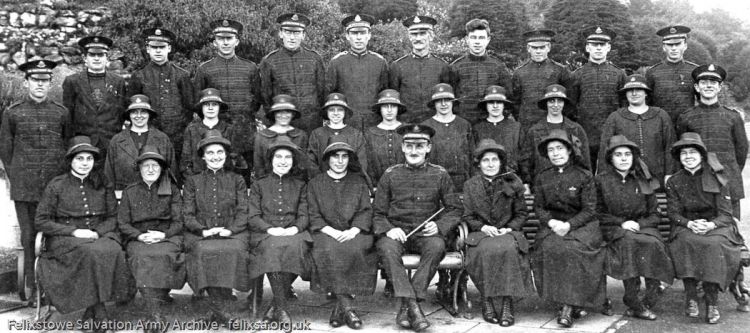
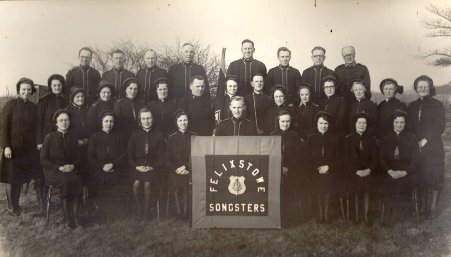
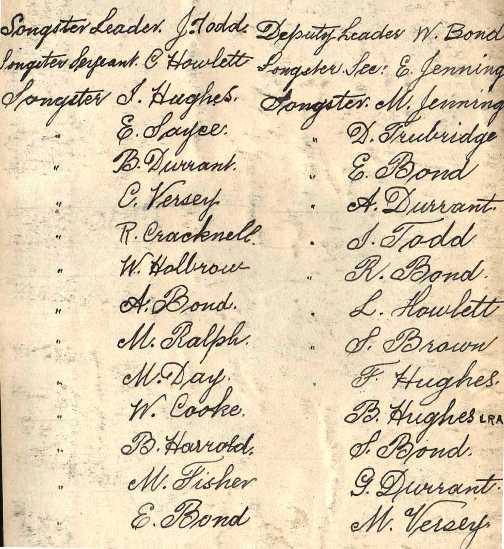
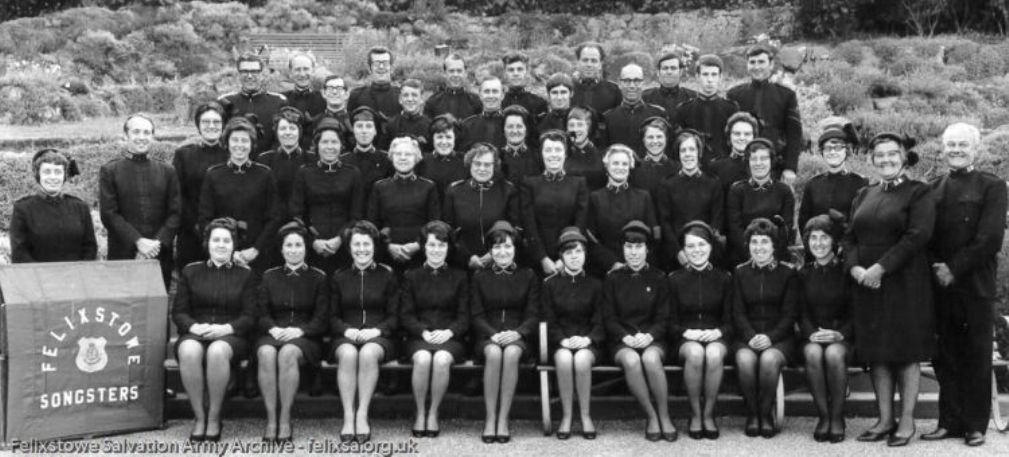
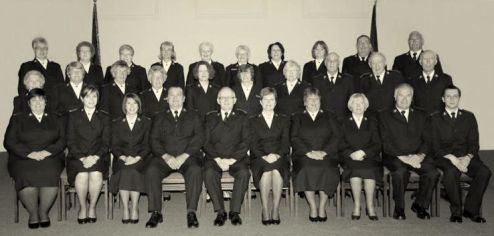
In the second picture Jack Todd is the leader, Brian Hughes is seated at the Triumph organ, and the COs are Adjutant and Mrs Ronald Topley. Doris Trubridge holds the flag. Barbara Aldis (nee Harrold) seated to the right of the organ, was the last to be promoted to Glory in 2014.
The 1969 photograph, taken in the gardens below the cliffs opposite where beach meetings were held for so many years, shows Clive Harrold as the leader, his sister Barbara Aldis as organist; the commanding officers are Brigadier Sidney & Mrs Daisy Barker. Note the twins, Anne Ranner & Janet Harrold (nee Johncock) in the photograph: they sang until joining the reserve in 2015 at age 80.
The Songsters in recent years
In the June 2011 photograph Neil Winton was the songster leader (centre) flanked by Captains Allister & Kathleen Versfeld.
The full list of the songsters in the photo is:
Back row l to r: Angela Barbrook, Marian Cracknell, Glennis Harvey, Sue Harrold, Bev De’Asha, Shirley Hinds, Sheena Williams, Libby Winton, Joseph Little, Robert Versey.
Centre row l to r: Elsie Bewers, Jean Versey, Anne Ranner, Janet Harrold (twins), Anne Hall, Maureen Cates, Sheila Harrold, John Ellitson, Clive Harrold, Dennis Versey.
Front row l to r: Gemma Fincham, Alicia Gray, Annette Scott (Deputy Songster Leader), Captain Allister Versfeld (CO), Neil Winton (Songster Leader), Captain Kathleen Versfeld (CO), Jackie Fincham, Ann Little, Trevor Baker, Simon Little.
Some Specialling Engagements
- Tunbridge Wells
- Chatteris Fortress
- Grimsby Victoria
- Maidenhead
- Jersey
Songster Leaders
- Arthur Jennings
- Harry Parker
- Jack Todd
- Dennis Versey
- Jack Todd (second period of leadership)
- Clive Harrold
- Neil Winton
- Kevin Gray
The over Sixties Club
Upon retiring to Felixstowe, Brigadier William Trinder, whose parents were COs in 1922, and his wife Ethel embarked upon establishing an Over Sixties Club at the corps. He was appointed leader and set out to raise funds and recruit members. The numbers soon grew to over 100.
From the corps history book
Three Generals have visited Felixstowe, General Higgins, General Larsson and General Peddle – though a few months before he was elected, whilst still Chief of the Staff.
- 1886 Official opening of the corps
- 1912 (August) The corps marked the promotion to Glory of the Founder with meetings led by Lieut.-Col. James Cooke
- 1914 Presentation of new instruments to the Band
- 1914 (June) Band attended the International Congress
- 1931 (2 June) Major Lilian Goodwin promoted to Glory as the result of a fall whilst stationed in Belfast
- 1932 (11 June) Wedding at Felixstowe of Captains Eva Parker & John Cooper by Commissioner Langdon, governor, Men’s Social Work. Band & songsters participated
- 1933 (February) Promotion to Glory of CS-M Arthur Jennings – killed in a road accident. As a Captain he opened Diss Corps
- 1933 Visit of General Higgins
- 1933 Visit of Chalk Farm Band
- 1939 Visit of the International Staff Band
- 1946 Promotion to Glory of Mrs Adjutant Eva Cooper (nee Parker) aged 41
- 1977 Visit of the Band to Germany and The Netherlands
- 1979 Corps moved to the former Congregational Church – opened by the BC, Commissioner Geoffrey Dalziel.
- 1984 BBC Songs of Praise broadcast from the Spa Gardens with the Band providing accompaniment.
- 1986 Corps Centenary Celebrations
- 1997 Visit of the Songsters to Jersey
- 2018 Visit of Commissioner Brian Peddle, Chief of the Staff
Officers who entered officership from Felixstowe
(year of commissioning)
- 1895 Sarah Chapman (later Broome)
- 1902 Lilian Goodwin
- 1930 (Mildred) Dora Trinder (later Hoar)
- —- Eva Parker (later Cooper)
- —- Beatrice Jennings (later Webb)
- 1936 Glenrosa Gorham
- 1936 Jack Knights
- 1936 Lilian Mays (later Day)
- 1936 William Todd
- 1937 Winifred Smith
- 1974 Linda Rayner (later Cooke)
- —- Shirley Cracknell
- —- Julia Gage (later Cozens)
- —- Sandra Battle (nee Cracknell)
- —- Stephen Battle
- —- Douglas Askew
- —- Glenys Askew (nee Jones)
- —- Louise Brown (nee Cracknell)
Officers stationed at Felixstowe
More than 150 officers have served the corps. Some of the officer ranks pre-1906 are not available; it must be remembered that International Headquarters and the British Territory’s National Headquarters were destroyed by enemy action in 1941 and much historical information was lost. These early officers are therefore assumed to be captains for the purpose of this record and their assistant (unless wives), lieutenants. If they are looking down from Glory and know this to be incorrect, please forgive us! The number of people still living that remember Mrs Brigadier Florrie Wagg taking her bonnet off to preach is fast diminishing, and there is an urgency to the collecting of historical detail.
Thanks go to Lieutenant-Colonel Jenty Fairbank who helped compile the list for the corps centenary in 1986.
- 1886 Captain John Reeve
- 1887 Captain John Avery
- 1888 (May) Captain Amelia Bailey
- 1888 (Oct) Captain Clinton
- 1888 (Nov) Captain Eliza Lindop (later Pigott)
- 1889 (Feb) Captain Alexander Greig
- 1889 (Aug) Captain Martha Pritchard
- 1890 (Mar) Captain Guffick
- 1890 (Aug) Captain Mary Madder
- 1891 (Jan) Captain Clarissa Partridge, Lieutenant Florence Young
- 1891 (Jun) Captain Harriet Blackwell
- 1891 (Oct) Captain Rose Neal
- 1892 (May) Captain George Cliffe
- 1892 (Oct) Captain Mercy Haynes
- 1893 (Feb) Captain Edward Prime
- 1893 (Aug) Captain Janet Cutmore
- 1894 (Mar) Captain & Mrs Thomas Hughes
- 1894 (Nov) Captain Sarah Clarke
- 1895 Captain Emma Burton
- 1896 (Feb) Captain Elizabeth Kenwright
- 1896 (Jul) Captain Montague Gough
- 1897 (Feb) Captain Emily Goss
- 1897 (Nov) Ensign George & Mrs Hettie Wright
- 1898 (May) Captain Thomas & Mrs Jinnie Edwards
- 1898 (Dec) Captain & Mrs Alex. Duncan
- 1899 Captain Frank & Mrs Charlotte Payne
- 1900 Captain Samuel & Mrs Martha Gott
- 1901 Ensign James Horace & Mrs Mary Ann Adkins
- 1902 (Aug) Captain Thomas & Mrs Margaret Wild
- 1902 (Nov) Captain & Mrs Frederick Piper
- 1903 (May) Ensign & Mrs H Spicer
- 1903 (Nov) Ensign & Mrs Horace Mann
- 1905 Captain Walter & Mrs Alice French
- 1906 Captain Ada Leach, Lieutenant Lilian Robinson
- 1907 Captain Jane Hincks, Lieutenant Hannah Thompson
- 1908 Captain Wilfred Simpson
- 1909 Captain & Mrs Arthur Kemble
- 1910 Captain Charles & Mrs Jennie Perkins
- 1911 Ensign Herbert & Mrs Nellie Parsons
- 1913 Ensign Herbert & Mrs Nellie Irven
- 1915 Ensign Samuel (& Mrs Rachel?) Mahaffey
- 1916 Adjutant Albert & Mrs Annie Searles
- 1917 Ensign Herbert & Mrs Harriet Cogswell
- 1918 Ensign John & Mrs Charlotte Hill
- 1920 Adjutant Walter & Mrs Bessie Wise
- 1921 Adjutant & Mrs Harry Yorke
- 1922 Commandant Thomas & Mrs Miriam (nee Busby) Trinder
- 1923 Ensign William & Mrs Beatrice (nee Simpson) Grottick
- 1924 (May) Ensign & Mrs Hugo Price
- 1924 (Oct) Adjutant Alfred & Mrs Maria (?) Hoy (the Adjutant was promoted to Glory aged 44 at the end of his stay)
- 1925 Adjutant & Mrs Robert Simpson
- 1926 Ensign William & Mrs Amy Price
- 1927 Ensign & Mrs William Hills
- 1929 Commandant & Mrs William Young
- 1930 Commandant Mary Collard, Commandant Constance Harvey (married the bandmaster, Leslie Howlett)
- 1931 Commandant & Mrs George Reeve
- 1932 Commandant David Rankin & Mrs Julia Parkhill
- 1934 Adjutant E Cross, Captain E Walkins
- 1935 Major & Mrs Sidney Woodall
- 1937 Major & Mrs Harvey Jones
- 1938 Adjutant John & Mrs Hilda (nee Collins) Vowles
- 1940 Major Mrs A Beaven, Captain Eva Davenhill
- 1941 Captain E Gardner
- 1942 Major & Mrs David Hazelwood
- 1944 Major William & Mrs Marion (Maisie) Deacon
- 1946 (Apr) Major & Mrs Thomas Watts
- 1946 (Aug) Adjutant & Mrs Ronald Topley
- 1948 Senior-Major William & Mrs Olive Davies
- 1951 Senior-Major & Mrs Robert Murray
- 1953 Senior-Major George & Mrs Florrie (nee Baker) Wagg
- 1956 Major & Mrs Ronald Chalk
- 1958 (Jan) Senior-Major Isa Milligan (pro tem, from DHQ)
- 1958 (May) Major George & Mrs Thomasina Riddle
- 1960 Brigadier Charles & Mrs Nellie (nee Babb) Downs
- 1964 Major Vaughan & Mrs Eva (nee Jones) Davies (son of the 1948 COs)
- 1966 Major Horace & Mrs Vera (nee Ingleby) Osborne
- 1968 Brigadier Sidney & Mrs Daisy (nee Daw) Barker
- 1973 Major Ronald & Mrs Madge (nee Stock) Doust
- 1978 Major George & Mrs Ann (nee Gardner) Bindeman
- 1980 Major Muriel Lund, Captain Cheryl Karmody
- 1982 Major Kenneth & Mrs Jean Harry
- 1984 Major Robert & Mrs Frances (nee Impey) Lake
- 1988 Major Peter Mylechreest
- 1990 Majors Peter & Valerie ( nee Schultz) Mylechreest
- 1993 Majors Dennis & Molly Ward
- 1996 Captains Godfrey & Diane (nee Harris) Payne
- 2005 Captains Alistair & Katherine Versfeld
- 2013 Captains Richard & Nicola (nee Jones) Waters
- 2018 Captains William & Stephanie Thompson (from USA East)
- 2019 Unofficered (CS-M John Ellitson)
- 2020 Majors David & Katerina (nee Hall) Lennox
- 2022 Captain Paul Williams & Lieutenant Lizette Williams
Officers’ Quarters
- 3 Stanley Cottages, Stoneylands
- 39 Falcon Street, Walton
- 2 Hawkes Lane, Walton
- St Andrews Road, Felixstowe
- Beatrice Avenue, Felixstowe
- High Road West, Felixstowe
Officers buried in Felixstowe
- Mrs Major Ada Deacon
- Major John Deacon
- Mrs Brigadier Marion (Maisie) Deacon
- Brigadier William Deacon
- Major Lilian Goodwin
- Colonel Lilian Glase
- Major Lilian Goodwin
- Brigadier Glenrose Gorham
- Mrs Commandant Miriam Trinder
- Commandant Thomas Trinder
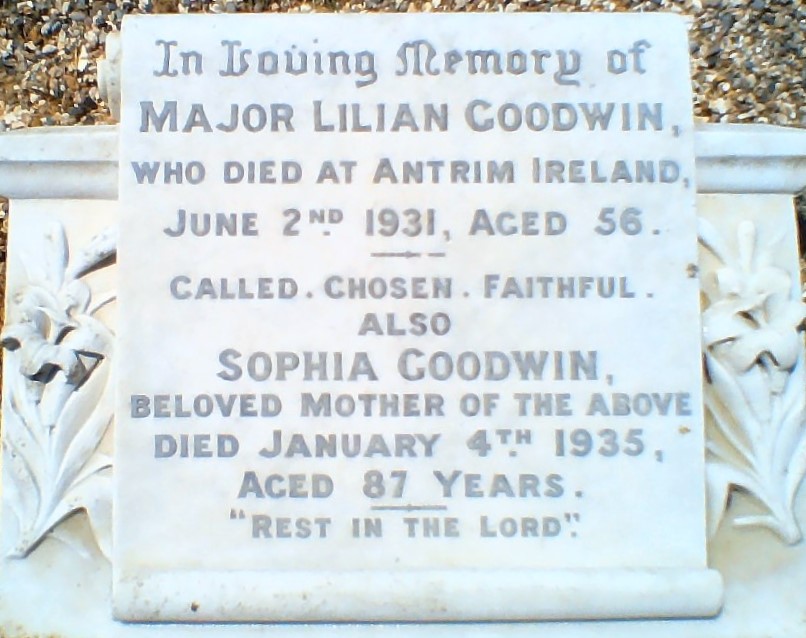
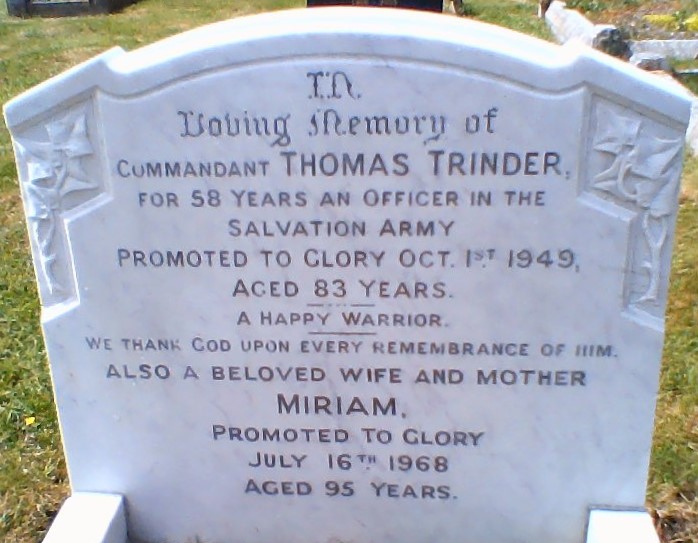
Gallery
